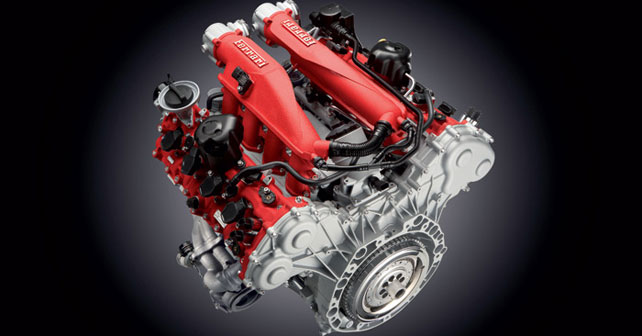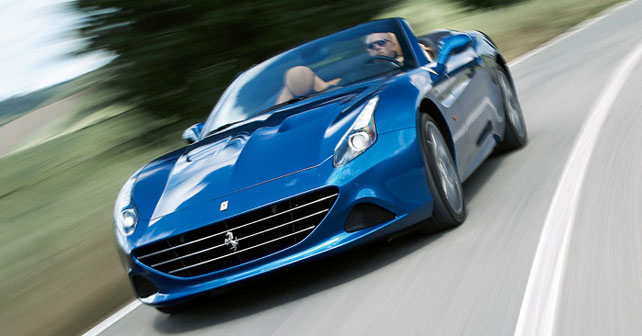The turbocharged engine returns to Maranello almost 30 years after the legendary F40. And not only does the power increase, but the response remains as urgent as before – so you don’t really feel the loss of the NA engine.
For as long as they could resist, they have. In Maranello, they lived in a paradise where naturally aspirated V8 and V12 engines ruled the roost – engines that were capable of dancing on the edge of 9,000rpm, and producing beautiful music while they were at it. But, eventually, they had to face reality. Reducing engine size, fuel consumption and emissions are rules that apply to you even if you only manufacture hallowed supercars starting at over Rs. 3 crores. And the straightforward solution, especially for the ‘relatively regular’ end of the line-up, is turbocharging. It may be the antithesis of the traditional “made in Maranello” engines – with qualities such as immediate throttle response, a soundtrack to die for, and a sky high rev limit – but with the latest emissions and fuel efficiency laws being applied, Ferrari engineers had no other option.
The biggest challenge facing Ferrari engineers was to ensure that they could retain the image of the brand. And while the Cavallino brand has used turbo engines before – that was in the 80’s, which was another era. The machinery was widely different then, and turbos were used in a very different way at that time. In those days, there was only one objective behind turbocharging – and that was to squeeze the maximum power out of the engines of extreme supercars such as the 288 GTO and the legendary F40. When it came to generating power, it was done without any compromises.
No Surrender
Almost 30 years later, the engine in the California T shows that a turbocharged motor can actually make one of the best sports car engines in the world. And it’s not just a matter of pure performance, because turbos have always been able to hit performance milestones. Doubts, if any, hovered around the sensation, feel and the perception of the car – which plays a large part in the appeal of a car that’s the equivalent of a fairly substantial real estate investment. But all those doubts evaporate instantly when you drive the California. It’s a revelation. It starts with immediate throttle response, even at low revs, and extends all the way to a fairly high rev limit – which is something that most turbo engines don’t feature. But, then, you don’t expect anything less from Ferrari. Of course, it’s not quite as deadly as the 458 Italia, but nonetheless it’s still amazing. In short, it’s yet another confirmation that no one in the world creates engines like they do in Maranello. One of the secrets behind this is varied torque management – with torque being delivered differently in each gear from third to seventh. In this way, the California’s engine mimics the behaviour of a normally aspirated engine, with the power delivery levels rising proportionally as the engine revs rise. And then, at high speed, the driver has the full grunt from the engine at his disposal – backed up by the 755Nm of torque from the new V8.
Getting the engine spot on and making the turbo lag almost imperceptible was not enough for the engineers, as they granted themselves a little narcissistic indulgence. In the centre console, between the air-conditioning vents, the wise men from Maranello have placed a turbo performance monitor. What catches your attention when the display shows how much power is at your disposal and how efficient the turbo is being. A good idea, no doubt – but when you start getting serious with the California, the last thing that comes to mind is to look at the meter. And it’s then that you discover the potential of the engine’s soundtrack. Sure, there are some small compromises here and there, but to pick them out it takes a fine ear and a certain familiarity with the soundtrack of the naturally aspirated V8. So, essentially, it takes a Ferrari to beat a Ferrari!
A perfect balance
With regards to other features, it could be said we’re up against the regular California. And that’s a compliment, since the driving experience is the same magical mix of virtues that makes a Ferrari different from any other car on the road – and, above all, able to captivate anybody, even those who don’t show much of an interest towards the ‘Cavallino’ brand. But the same extraordinary feeling is now even more intense thanks to several improvements, like a 30mm lower V8, more direct steering, improved traction control (F1 Trac), and a completely reworked Magnaride suspension system. The California showcases the same perfect balance as before – making it both a grand tourer and a sports car. Of course, if you want to get more serious in a Prancing Horse you can always choose between the 458 and F12. In the California, it’s quite straightforward to switch between its dual nature – all you have to do is play with its steering-wheel mounted manettino switch. We ended up driving the California mostly in sport mode. Well, it is a Ferrari after all! On the other hand, the options available on the California’s manettino are not so many – with only Comfort, Sport, and ESC off available. The addition of at least another mode or two wouldn’t have been a bad idea – if for no other reason but to match the other Ferrari models, which have at least four or five positions.
From coupe to roadster
The convertible top (both in terms of design and mechanism) is one of the few features that have been carried over in the California. And, as in the past, it takes only 14 seconds for the car to transform from a coupé to a roadster and vice versa
Instrumentation crafted with precision
The new California has a large reconfigurable display in the instrument cluster, but the massive, and beautiful, rev counter mounted in the centre is a symbol of precision mechanics. The same can be said of the speedometer to its right. The indicators, headlight switches, and wiper controls have been shifted to the steering wheel, which is where the manettino also resides. Above, you can see the classic Ferrari buttons – reverse, automatic, and launch control.
Know-How
Under the guise of downsizing
Reducing engine size without any loss in performance is commonly solved by adding a turbocharger. Whereas this has been widespread on mass-market cars for the past decade, in the California downsizing has been applied at a totally different level. The California had a 4.3 litre engine that has been reduced to a 3.8 – with the addition of a pair of twin scroll turbos (the net result is an increase of 69bhp). To avoid losing that typical character of a Ferrari engine, the engineers from Maranello worked hard on different fronts – obviously the flat-plane crankshaft has been retained, and a lot of work was done on the management of boost pressure (which reaches a peak of 1.4 bar), as well as the exhaust manifolds. The latter is the result of a long improvement process – resulting in a complex maze of same-length pipes to improve both the sound and character of the V8.
Five in one
The turbo performance meter shows, in real time, how much response is available from the V8 turbo motor. Moreover, not only does it show how efficiently the turbo is being used but also classic features – such as boost pressure, time and outdoor temperature
Driven model
California T
3,855cc – 90° bi-turbo V8
553bhp @ 7,500 rpm
755 Nm @ 4,750 rpm
Rear-wheel drive
7 speed Dual-clutch transmission
Max Speed: 316km/h
0-100km/h: 3.6s
Average fuel consumption: 9.5km/l
Weight: 1,730kgs
© Riproduzione riservata



























Write your Comment